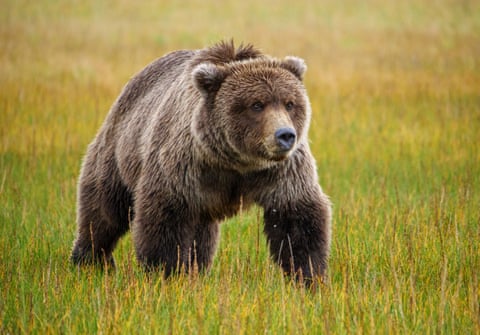The grizzly bear had already poked around the camping site before being shooed away, but this time it wasn’t to be deterred. After it caught the waft of stashed food in its nostrils, the bear tore into the tent’s canvas.
The outcome was grim. Leah Davis Lokan, a 65-year-old described posthumously as “incredibly strong, incredibly athletic, brave, fearless” lay mortally wounded, the collapsed tent partly covering her body.
“I am a nurse. I have seen a lot of trauma in my life, and I knew it wasn’t good when I saw her,” says Katie Boerner, a friend who was camping with Lokan and the victim’s sister, Kim, during a stop-off on the Great Divide cycle route that traverses the spine of the Rocky Mountains all the way to New Mexico.
The mauling, which took place on 6 July, brought unprecedented uproar to Ovando, a tiny hamlet nestled in a picturesque valley of western Montana. “It was complete pandemonium, there was a lot of screaming and crying going on,” says Fred Valiton, who runs Ovando’s only guest house and was called to the incident as part of the local volunteer firefighting team.
Lokan succumbed to her injuries quickly, Valiton says, mimicking the hefty swipe of a bear’s paw. “They’re very strong and they’re made to kill things,” he says. The rescue team attempted to save her regardless, albeit with some nervousness. “You certainly don’t need a bear sneaking up on you while you’re trying to do CPR in the dark,” says Valiton.
The grizzly had fled after being doused in anti-bear spray by Kim Lokan and was spotted two nights later by wildlife officials using night vision goggles as it raided a chicken coop. The 400lb male bear was felled by marksmen, and DNA tests confirmed it was responsible for the death. Locals say Lokan had a granola bar and perhaps some berries in her tent, which attracted the bear even after she had moved the food, although an official investigation is pending.
Two decades ago a hunter was killed by a grizzly in woodlands not far from Ovando, but no one in this village of 50 souls had known anything like this to happen right in the heart of town. “It shocked us to our core,” says Valiton. “It was our absolute worst nightmare.”
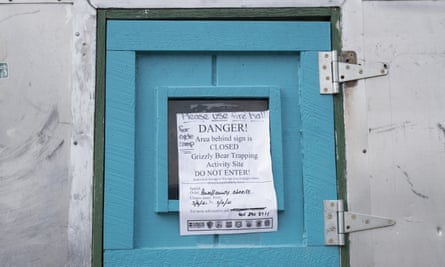
A fatal encounter with a grizzly bear, or any bear, is exceptionally rare. “You’re literally more likely to be struck by lightning than attacked by a bear,” says Kim Johnston, who has worked as a bear specialist for the state government – but many in Montana view Lokan’s death as further evidence that a burgeoning and spreading grizzly population, aided by four decades of federal protection, is now increasingly bumping up against residents and visitors of the US west.
The number of bears is increasing as a growing number of people seek a bucolic slice of what was once bear habitat. The human population in bear strongholds in south-west Montana has escalated by up to a third over the past decadeand house prices in Bozeman have exploded to the extent that one local man resorted to holding up a sign downtown that read “Please sell me a home.” The two species now share more mutual startled gawps and more conflicts.
Human-bear interactions are increasing, researchers largely agree, with these encounters involving a mixture of tragedy, ignorance and sheer bad luck. In April, Charles “Carl” Mock was killed by a grizzly bear after he inadvertently wandered too close to a moose carcass in Yellowstone national park. A month later, Samantha Dehring, a tourist from Illinois, got to within 15ft of a Yellowstone grizzly, which is against park rules, to take a photo and had to flee the riled bear. In August, a couple of hikers near the town of Ennis were injured after they bumped into a sow grizzly bear with her cubs.
Can Americans willingly cede space and some lifestyle habits to aid the ongoing recovery of a large, potentially dangerous predator that pads around in their midst? And if they can, what is the tolerance for such coexistence when lightning bolt events inevitably strike down the next Leah Davis Lokan?
As dominant, ravenous omnivores able to devour everything from seeds to elk – “they are essentially noses attached to stomachs with feet on them,” said Ryan Lutey, executive director of the Vital Ground Foundation – grizzlies once numbered about 50,000, stretching from the far reaches of Alaska down to central Mexico.
But loss of habitat, conflict with landowners who feared for their livestock and rapacious hunting cut grizzly numbers down to a few hundred. California’s flag is still adorned with a grizzly, even though the last California grizzly was shot in 1924. By 1975, when the species became federally protected, the last remaining grizzlies in the lower 48 states were clinging on in Yellowstone and Glacier national park.
From these isolated outposts, a slow but steady resurrection has taken place. Female bears have just two or three cubs in a litter and it’s fortunate if one survives to adulthood, so it hasn’t been a soaring comeback. But the bears have spread north and west from Yellowstone, and south from their northern extent to the point that through mountain foothills and valleys these two main populations – together numbering about 1,500 – are now only about 30 miles apart.
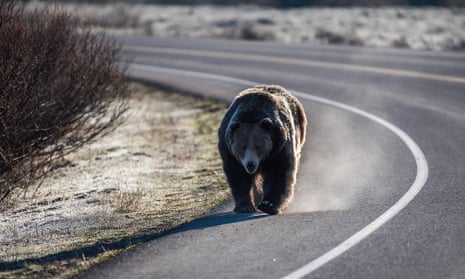
Technically, the Yellowstone population has “recovered”, having surpassed the government goal of 500 bears, but conservationists say the link-up of isolated pockets of bears to one large area of connected habitat covering parts of Montana, Idaho and Wyoming is vital if there is to be a stable, genetically diverse species.
Removing protections for grizzlies now will imperil a creature that is still confined to barely 3% of its historical range, according to David Mattson, a bear scientist formerly with the US government.
“We have sort of muddled through until now but throwing this species over to the mercy of the states would be a horror show,” Mattson says. “That 500 number was pulled out of people’s collective ass – it’s no longer scientifically defensible. You need to get that connectivity through the range as part of the recovery goals, and we don’t have that yet.”
He added that hunting bears to somehow engender fear of humans has “zero basis in evidence or logic”, given grizzlies are mostly solitary predators that do not pass on such worldly advice to other bears.
Lawmakers in the Republican-dominated Montana legislature have reacted pugnaciously to conservation questions. In May, it shuttled two new bills to the desk of Governor Greg Gianforte, a Republican, for his signature – one that would strip grizzlies of endangered species protections and another that would allow people to shoot the bears if they damage property – say, a cow – rather than just in a situation where someone’s life was in danger.

These new laws are probably mere defiant gestures given they violate federal statutes – bear researchers have regardless decried them as harmful and counterproductive – but they have struck a chord with some who believe grizzlies should be hunted to curb their gradual re-emergence. On Thursday, state officials in Wyoming formally requested that the federal government remove the grizzly from the protected species list.
Valiton’s family has had a cabin in the Ovando region since the 1950s, and he barely remembers seeing any bears until relatively recently. His property, at the foot of a tree-ringed mountain, is now a sort of highway for grizzlies – he will often see several in one evening nosing through piles of hay or clawing at rotting logs. Valiton will happily show off pictures he has taken from the safety of his porch; the animals retreat if he walks any closer.
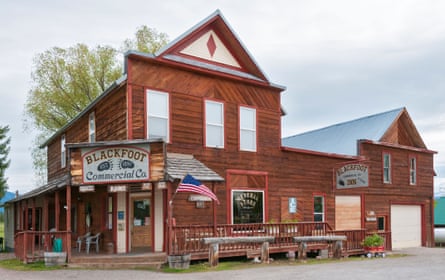
“It was once a major thing to see a grizzly bear, but their numbers have grown exponentially,” says Valiton. He likes the animals, but feels they now need to know their place.
“They are not afraid of us, they’ve got used to us. People and bears don’t mix and we’ve got to make them scared of us again. We have to educate the bears that we are not supper,” he says. “We think there ought to be hunting season on them. They’re a magnificent animal, but they’ve outgrown their welcome.”
In their journals chronicling their westward exploration, Lewis and Clark describe coming across a “verry large and a turrible looking animal” that Native Americans would only tackle with at least half a dozen warriors.
In 1805, Lewis wrote breathlessly of “a most tremendious looking anamal, and extremely hard to kill notwithstanding he had five balls through his lungs and five others in various parts”. Several of the party had confrontations with a species given a Latin name unsubtle in its judgment: Ursus arctos horribilis, or “horrible northern bear”.
Despite this troubled past, a sort of uneasy truce has allowed grizzlies to venture into places they haven’t been seen for a century or more. Having a “problem” grizzly is far more like having an unruly neighbor – one that raids bird feeders and chicken coops, strips apples from trees, crunches beehives or hauls off the odd dead calf – than a deadly foe of humans. Most grizzlies avoid any contact with people, and those deemed too interested in us can be trapped, darted and relocated.

Some even become minor celebrities – a bear called Grizzly 399, an enduring presence in Wyoming who has her own Facebook page and Instagram account, is regularly stalked by dozens of wildfire photographers recording her every move. Another, known colloquially as Felicia, is known to graze upon the clover on the roadside at Togwotee Pass, not far from Yellowstone, causing huge traffic jams of gawking onlookers. (Wildlife officials recently attempted to move Felicia on from public viewing by “hazing” her with exploding cartridge shells and bean bag shots.)
Still, the hulking presence of grizzlies can be unnerving to newcomers. “I get calls all the time from people freaked out that they’ve seen a bear. Especially since Covid we’ve seen all these wealthy baby boomers decide to retire and buy up property here,” said Jamie Jonkel, a bear management specialist at Montana fish, wildlife and parks. “We are developing on prime bear habitat and a lot of newer people just aren’t used to being around bears, don’t do commonsense things. A lot of them are just clueless.”
The concept of coexistence has taken root with some established Montanans, however, with a growing number prepared to erect electric fences and remove dead animals to avoid having to resort to deadly retaliation.
On the outskirts of Ovando, in the lush Blackfoot valley, a coalition of ranchers has taken to putting up barriers and switching practices to maintain a distance between the bears and their livestock.
“The normal way of ranching changed in a hurry because all of a sudden you had these critters with big teeth,” says Jim Stone, a rancher whochairs Blackfoot Challenge, a nonpolitical group that aims to conserve the watershed. “You have to do something to keep those rascals out.”
Stone has installed four miles of electric fence to keep out grizzlies, and his son has welded a metal electrified plate beside the front gate for the same purpose. Any cow carcasses are swiftly transported to a local fenced facility that composts them. Some of Stone’s neighbors still dislike bears but the arrangement has ensured a semblance of harmony. “We are trying to think bigger, to try to eliminate that human conflict element,” he says.
A clutch of organizations are now finding plenty of work in educating the public on how to behave when living near or visiting bear country. “We really want to get ahead of the conflicts,” says Kim Johnston, the former Montana state official who is now a field project manager for People and Carnivores, a Montana human-bear conflict reduction organization.
Johnston studies communities to see what would work best – electric fencing, perhaps, or guard dogs to protect livestock – and runs courses on how to use bear spray.
“Some people think they need to spray it around their campsite, but it’s not a repellent,” says Johnston as she demonstrated how to flick the safety cap off the canister and spray an imaginary grizzly. “If you’re hiking along and see that bear you want to stop, remain calm and have your bear spray ready.”
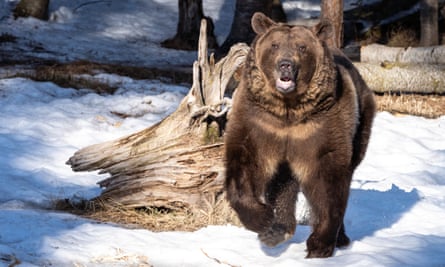
On a crisp September morning, Johnston loaded two bear-proof garbage bins to take to a campsite in Virginia City, a town formed from a 1863 gold rush located 85 miles north-west of Yellowstone. The town has retained such a distinct wild west aura that tourists can be entertained by shootout re-enactments.
Black bears have long been so common that they once walked the main street and nosed through bins, but the recent sight of a more formidable grizzly a mile from town prompted officials to install sturdier waste disposal. Residents were asked to cut down on anything that would lure an itinerant bear. “It really stirred people up,” says Johnston of the grizzly sighting.
The new bins contain a cylinder which you must reach into to release a switch that opens the top, a device that has stymied grizzlies to the extent they have been videoed jumping up and down on the receptacles in a hungry rage.
A nearby campsite, the Rambling Moose, sits beside woodland at the top of a plunging valley. The owners see themselves as working in the bears’ back yard, rather than the other way around.
“They were here first, let’s be honest,” says owner Kim Jorczyk. “You take precautions, you take protective measures and you respect the wildlife.” She believes the onus should be on people’s behavior in the wild, recalling how one camp guest was chased under a cedar tree by an irate moose. “The idiot got too close to try to take a photo,” she says.
The continued recovery of grizzly bears may well come down to how much responsibility, collectively, humans will take for seemingly mundane actions that may put us at risk. Humans have demonized large predators for centuries, and have responded with violence after they bite back – in this, grizzlies share much with sharks and wolves – but perhaps in this instance, humans could be the ones to compromise a little.
For all the angst, the chances of a grizzly attack are once in every 2.7m visits toYellowstone national park. There have been just 16 recorded bear-caused human fatalities since 1892 in the entire ecosystem, despite millions of visitors each year.
Perhaps our lingering fears come from a sense of recognition. Jonkel, the Montana bear management specialist, says that facing a grizzly sparks “something ancient, representing the last stand of what is intact wild country”. Grizzlies will “take advantage of us, just like we will of them”, he says. “We are very similar. We both like the good life, the easy life.”
“We have special stories about bears, they have deep roots,” said Mattson. “They are intelligent omnivores, like us. They can stand on their hind feet, like us. They are capable of dedicated maternal care, like us. It can be challenging living alongside them, yes. But we can look into the eyes of a bear and see ourselves.”
